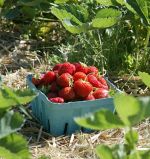
|
||
|
|
|
|
| Forgot Password | ||
Growing Strawberries in the Garden
Posted by G_I_A |
Added on : May 20, 2010 2:12pm |
Last edited: June 14, 2010 03:57am | Viewed 1629 times
| 0 Comments | This article is also in bushel basket
and bushel basket
Strawberries are an easy to grow fruit crop that will reward the home gardener with ample harvests for many years. With favorable conditions, each strawberry plant should produce one quart of strawberries.
 Basic considerations when locating a strawberry patch include: full sun, well drained, sandy loam with a pH from 5.8 to 6.2 is ideal, and don't plant where tomatoes, potatoes, peppers or eggplant have been grown recently (Verticillium Rot).
Basic considerations when locating a strawberry patch include: full sun, well drained, sandy loam with a pH from 5.8 to 6.2 is ideal, and don't plant where tomatoes, potatoes, peppers or eggplant have been grown recently (Verticillium Rot).
What ever planting method you choose, the following rules apply: 1) Plant in the spring as soon as the soil is dry enough to be worked, or in late fall. 2) Be sure you have certified disease-free plants. 3) Select plants with large crowns with healthy, light-colored roots. 4) Amend soil with 1-2 inches of organic matter like compost or well- rotted manure. 5) Keep weeds from competing with your strawberry plants. 6) Make a hole large enough to spread the roots. Hill the center of the hole and place the crown at soil level. Spread the roots downward on the hill. Bury the plant so that the soil only goes halfway up the crown.
Mulch between plants after planting to keep the soil temperature cool, deter weeds and to keep the fruit off the soil. Straw is the traditional strawberry mulch. Do not use black plastic since it will raise the soil temperature and optimal fruit production requires cool soil.
In colder climates, mulching over the strawberry plants will prevent injury to the crowns. Wait until the temperature drops to 20 degrees F. and cover with several inches of straw or pine needles. Be sure to use a mulch that can be easily removed in the spring.
1 - 2 inches of water per week is needed for juicy fruit. Water is especially important while the fruit is forming, from early bloom to the end of harvest.
Start with a rich, organic soil. Apply a balanced fertilizer (10-10-10) at planting at the rate of one pound per 100 sq. ft. Fertilize again after renovation of June bearers or second harvest of day neutrals and everbearing types. Do not over fertilizer or you will have excessive leaf growth and poor flowering. Do not fertilizer strawberries late in the season in colder climate to prevent new growth that will be damaged by frost.
Strawberries are their sweetest when fully ripened on the plants. For most varieties this means leaving the berries on the plant for a day or two after they are fully colored. The only way to know for sure is a taste test.
Strawberries bruise easily. Be gentle when pulling them from the plants. Snap the stem directly above the berry rather than pulling on the berry itself. Keep harvested berries in a cool, shady location.
The following are known strawberry pests: 1) Verticillium Wilt, Botrytis (Fruit Rot) and Red Stele (Root Rot): Choose resistant varieties and rotate crops. 2) Tarnished Plant Bug: Feeding by the tarnished plant bug will result in disfigured, nubby berries 3) Birds: Birds will inevitably get some of your berries. Plant more than you'll need and cover the area with close bird netting.
 Basic considerations when locating a strawberry patch include: full sun, well drained, sandy loam with a pH from 5.8 to 6.2 is ideal, and don't plant where tomatoes, potatoes, peppers or eggplant have been grown recently (Verticillium Rot).
Basic considerations when locating a strawberry patch include: full sun, well drained, sandy loam with a pH from 5.8 to 6.2 is ideal, and don't plant where tomatoes, potatoes, peppers or eggplant have been grown recently (Verticillium Rot).


Be the first one to comment on this article